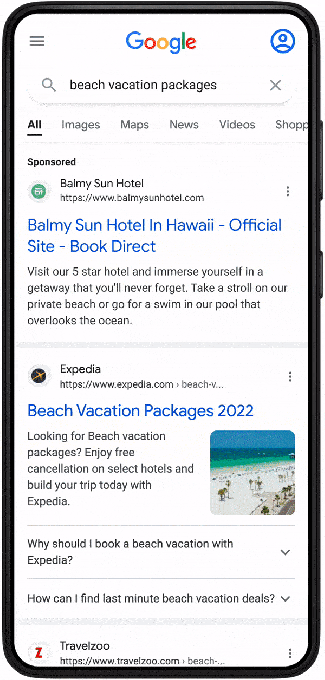New Google Ad Labeling
TechCrunch recently highlighted how Google is changing their ad labeling on mobile devices.
A few big changes include:
- ad label removed from individual ad units
- where the unit-level label was instead becomes a favicon
- a "Sponsored" label above ads
- the URL will show right of the favicon & now the site title will be in a slightly larger font above the URL
An example of the new layout is here:

Displaying a site title & the favicon will allow advertisers to get brand exposure, even if they don't get the click, while the extra emphasis on site name could lead to shifting of ad clicks away from unbranded sites toward branded sites. It may also cause a lift in clicks on precisely matching domains, though that remains to be seen & likely dependes upon many other factors. The favicon and site name in the ads likely impact consumer recall, which can bleed into organic rankings.
After TechCrunch made the above post a Google spokesperson chimed in with an update
Changes to the appearance of Search ads and ads labeling are the result of rigorous user testing across many different dimensions and methodologies, including user understanding and response, advertiser quality and effectiveness, and overall impact of the Search experience. We’ve been conducting these tests for more than a year to ensure that users can identify the source of their Search ads and where they are coming from, and that paid content is clearly labeled and distinguishable from search results as Google Search continues to evolve
The fact it was pre-announced & tested for so long indicates it is both likely to last a while and will in aggregate shift clicks away from the organic result set to the paid ads.




Comments
Upon seeing this, the first thing that comes to mind is - dark patterns. Even if a user sees the word "Sponsored" at the top, the first ad is followed by questions which look almost identical like the "people also ask" section. This makes all subsequent ads almost indistinguishable from organic results. These are plain and simple deceptive design practices. Advertisers are decreasing their marketing budgets as recession looms, so this is perhaps the reason for these changes in SERPs design. But I'm pretty certain that these changes are here to stay if they will result in more ad clicks, recession or not. If this continues, what's the point of SEO?
...about a half year ago where he mentioned SEO being about stopping the bleeding or slowing the bleeding rather than growing.
A buddy I know who is huge into PPC has been on multiple Google ad rep calls where they did not know he was also on the call & Google suggested cutting him out of the equation, using automated bidding, and/or increasing bids 20% across the board to offset inflation. Like they were promoting spending more not to get more, but just to spend more ... without any promise of additional conversions or value to the advertiser.
Google's ad team has also told SaaS players to use the narrative of inflation to adjust their pricing higher so that they can bid more aggressively on Google ads.
As G has growed up, we benefit from the inevitable loss of flexibility. The pilot boat can turn at any time, but the tanker must plan its turns far in advance.
The hints are more certain now, as the investments into the future path are more substantial (sometimes irrecoverable, thus the momentum down the indicated path).
How far off is the new formal product offering "brand exposure" ?
Clearly this "experiment" provided the data supporting that... and real-world deployment (starting now) is likely stored accordingly, to support the sales & marketing effort.
Wouldn't you buy that opportunity, while also paying per click via the existing sales of that?
“Brands are the solution, not the problem. Brands are how you sort out the cesspool.”
When I read that at the time I read it as "branded advertisers invest in brand & thus can pay more than direct marketers, who will soon be viewed as a form of spam as soon as brands with guerilla ad bids enter their market."
Add new comment